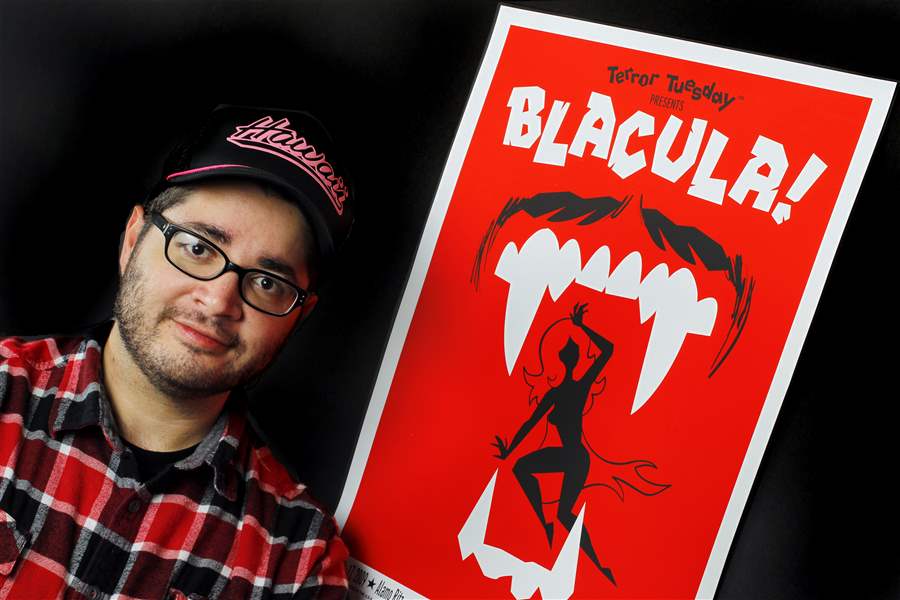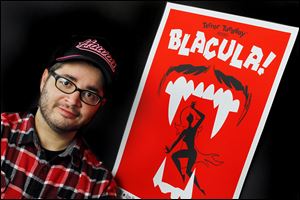
Artists shun bland promos for films, return to era of movie posters as art
1/19/2014
Mitch Ansara with one of his movie posters.
The Blade/ Andy Morrison
Buy This Image

Mitch Ansara with one of his movie posters.
“Art is either plagiarism or revolution,” French Post-Impressionist artist Paul Gauguin once wrote.
And while Gauguin considered these trends to be mutually exclusive, more than a century later a group of mostly unknown artists are, in a practical sense, doing both, fueling the underground and worldwide phenomenon of alternative -- some say re-imagined -- movie posters.
It’s a growing trend -- perhaps protest is more appropriate -- that pays homage to and resurrects the decades-old tradition of the movie poster as art.
“It’s like the saying goes, you don’t what you’ve got until it’s gone and when the poster illustrations began to disappear, I think a lot of people were wondering where did it go, what happened to this great art?” said Kevin Burke, a Toronto filmmaker who is making a documentary on the reimagined-movie poster craze. “Now with the alternative film art out there, they’re kind of getting their fix. That void is being filled.”
To be clear, the movie poster is not dead. It’s just that it might as well be. Where these 24-by-36 works were once beautiful, thoughtful pieces designed to illuminate a film’s theme or message by legendary artists like Saul Bass, now they’re more often bland promotional tools heavy on celebrity that, ironically, are as generic and soulless as the films they promote.
Seriously, what’s the last film poster you’ve seen that inspired any kind of noteworthy emotion that comes with good art?
Mitch Ansara doesn’t recall many. His response, like many other artists, was to make his own. It started in 2008 with Space Jam — yes, the Michael Jordan meets Bugs Bunny and Co. classic, which he reimagined as a 1960s book cover. It was part of what would become his tongue-in-cheek series "I Can Read Movies," a lampoon of the “I Can Read Books” from the 1960s and 1970s.

“It just came to me … [and] people thought it was funny,” said the 30-year-old Toledoan, one of 100 artists featured in the new coffee-table book, Alternative Movie Posters: Film Art From the Underground ($34.99, Schiffer Publishing Ltd.), by Matthew Chojnacki. “So every day I would do a different one. I would wake up, wondering what movie am I going to watch today day. I would pick and movie and watch it and then draw a fake cover for that.”
Among the many movie posters he’s reimagined are Mean Girls, Sixteen Candles, and Blacula! The latter is Ansara’s best-known poster, a 2009 commissioned work for The Alamo Drafthouse in Austin for a special screening of the 1972 blaxploitation classic starring William Marshall. It’s a poster that modestly captures the allure of the film in three images: Marshall's wispy-thin black mustache crowning white fangs with the dark silhouette of a naked woman in between.
More striking, however, are Ansara’s Mean Girls and Sixteen Candles pieces, which are clearly Bass inspired: 1960s minimalist graphic designs and limited color -- white and pink images on a black background -- that boldly convey the film’s intent. Mean Girls, for instance, features a disembodied hand holding scissors that are about to cut the strings to the hearts dangling below. Sixteen Candles is more literal -- 16 burning candles arranged in a pink and white heart -- though no less thoughtful.
"The early ones were ... kind of choppy, like it’s cut out of paper. And then I went into the ’70s, when everything was cleaner, the lines were cleaner,” Ansara said of the "I Can Read Movies" series. “Shapes were really fun back then, the way they played with them."
The three posters are among those in Alternative Movie Posters, which features 100 artists and their work, including reimagined posters to Jaws, Ghsotbusters, Star Wars, and Blade Runner.
It was a project Chojnacki spent a year putting together, contacting artists from around the world, receiving permission to use their artwork, and then assembling it for the book.
For the 38-year-old Cleveland writer and blogger, Alternative Movie Posters represents the response to the decline of a once-great art form.
“I used to collect movie posters from the mid-’80s and ’90s,” he said. “Now it’s less about art and now more about communicating who’s in the film,” Chojnacki said.
It was the alt-poster scene, though, that renewed his faith in the art form.
It was a scene that began years ago as fan art, he said.
“But the quality of the work got really decent about four or five years ago, and exploded two years ago. Now every day stellar posters are coming out.”
It’s an origin story often compared to the decades-old tradition of gig posters done by underground artists, the re-imagined movie posters were originally sold at film festivals and cult film screenings as one-offs to collectors. Then Austin-based mondotees.com started selling the screen printed posters as limited-run T-shirts and posters, with prices ranging from $10 to $4,000.
“Mondo would announce a sale and you would have 30 seconds to get that shirt and that’s about it,” he said.
The scene has grown big enough to include a few “superstar” artists, Chojnacki said, who have had their work displayed at gallery exhibits. But the majority are graphic artists who are using their posters as a career launching platform. They put the work out there, others notice, and more work comes in. But it's rarely Hollywood.
Ansara's poster work led to professional jobs creating alternative posters for the Clash of the Titans remake, Aeon Flux, Paul Blart: Mall Cop, and more recently, R.I.P.D. But those were just "mini-gifts," he said, "to give to the cast and the crew."
What he wants is an opportunity to create film posters that aren't alternatives sold at film festivals and online, but the original artwork that appears in movie theaters as part of the movie’s marketing plan. Meanwhile, he'll continue to put his work on his Web site, spacesick.com, for free and hope that a film studio takes notice of his work.
"It's depressing," he said. "You can just open that book and see all those talented people who could be making these posters" for the studios. I’m surprised that the studios haven’t jumped on these people who have been doing this for years, me included."
Contact Kirk Baird at kbaird@theblade.com or 419-724-6734.